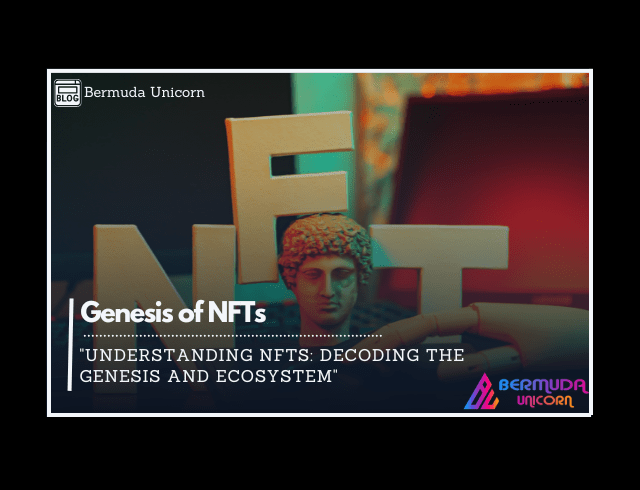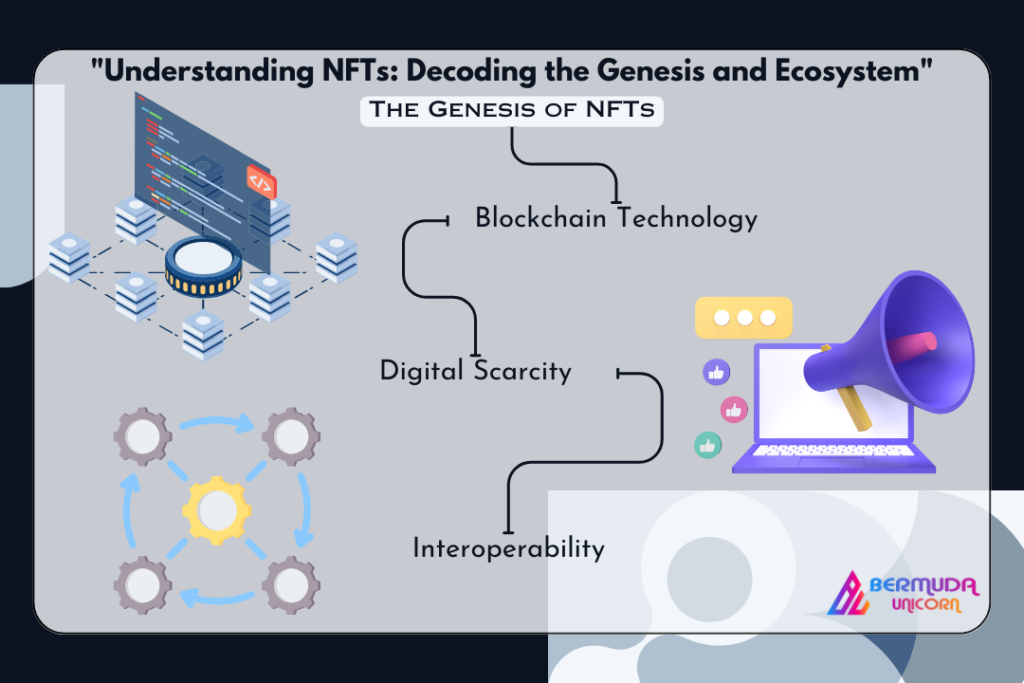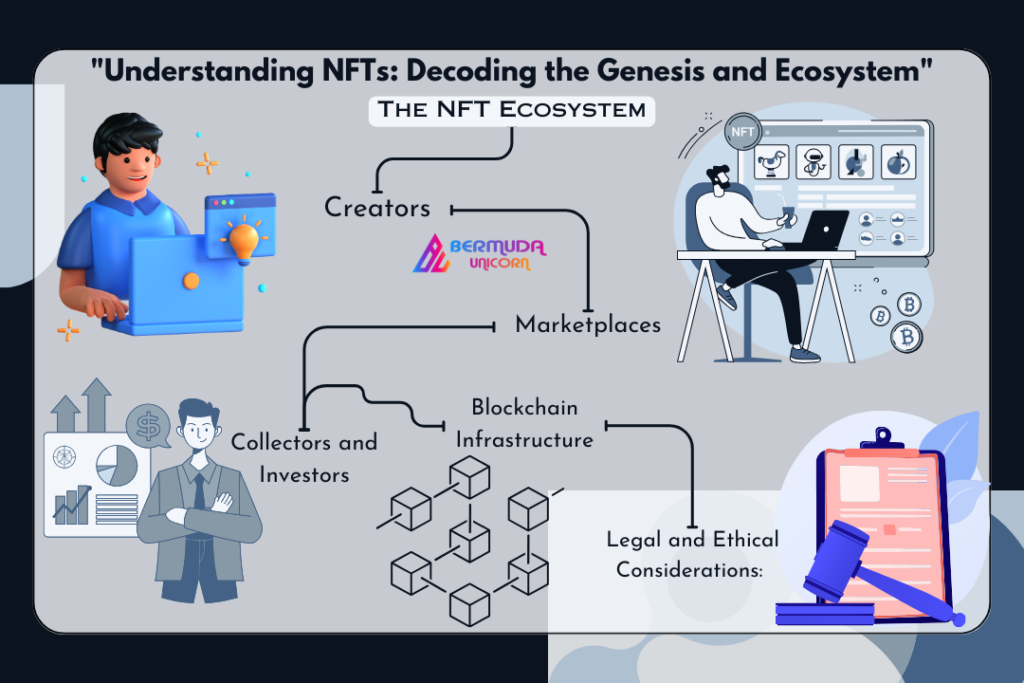![]()

Introduction
In recent years, Non-Fungible Tokens (NFTs) have emerged as a revolutionary force in the digital world, capturing the attention of artists, collectors, investors, and tech enthusiasts alike. These unique digital assets have sparked discussions, controversies, and significant transactions. Also, to truly appreciate NFTs and their place in the digital ecosystem, it’s crucial to delve into their genesis and explore the ever-evolving NFT landscape.
The Genesis of NFTs
Non-fungible tokens, or NFTs, are a digital representation of ownership or authenticity, utilizing blockchain technology to establish and verify their uniqueness. Also to understand NFTs better, it’s essential to explore their genesis, which can be traced back to the convergence of several key technologies and ideas:
1. Blockchain Technology:
The foundation of NFTs lies in blockchain technology, also which ensures transparency, security, and immutability. Also, Ethereum – a blockchain platform known for its smart contract capabilities, played a pivotal role in making NFTs mainstream by introducing the ERC-721 standard.

2. Digital Scarcity:
The concept of digital scarcity was a critical breakthrough. In the physical world, owning an original piece of art or a rare collectible is a status symbol. NFTs bring this concept to the digital realm by allowing creators to tokenize their digital assets and make them scarce, creating a sense of ownership and value.
3. Interoperability:
NFTs are not restricted to a single platform or ecosystem. They can be bought, sold, and traded across various marketplaces, creating a decentralized and open ecosystem. Also, this interoperability has been a key factor in NFTs’ rapid adoption.
The NFT Ecosystem
The NFT ecosystem is a dynamic and multifaceted space that encompasses various stakeholders and activities. Let’s break it down:
1. Creators:
At the heart of the NFT ecosystem are creators. These individuals or entities produce digital art, music, videos, virtual real estate, and other digital assets that can be tokenized as NFTs. The rise of NFTs has allowed creators to monetize their work directly, reducing reliance on intermediaries.
2. Marketplaces:
NFT marketplaces serve as the digital bazaars where NFTs are bought, sold, and traded. Platforms like Bermuda Unicorn, Rarible, and SuperRare have emerged as popular marketplaces. Each has its unique features and focuses, catering to different types of NFTs and creators.
3. Collectors and Investors:
NFTs have attracted a diverse community of collectors and investors. Some are drawn to NFTs as a form of digital art collecting, while others view them as an investment opportunity. The scarcity and provenance of NFTs make them appealing to both groups.
4. Blockchain Infrastructure:
The blockchain infrastructure that underpins NFTs is a crucial component of the ecosystem. Ethereum remains a dominant platform, but other blockchains like Binance Smart Chain and Flow are gaining traction. Each has its strengths and limitations, influencing the types of NFTs and activities they support.

5. Legal and Ethical Considerations:
The NFT space is still evolving, and legal and ethical considerations are becoming increasingly important. Issues related to copyright, plagiarism, and environmental concerns have come to the forefront, prompting discussions and initiatives to address these challenges.
6. NFT Use Cases:
NFTs extend beyond digital art. They find applications in gaming, virtual real estate, music, sports memorabilia, and even social tokens. Also, this versatility broadens the potential of NFTs and their impact on various industries.
Challenges and Opportunities
While NFTs have brought exciting possibilities to the digital world. But, they also face several challenges:
1. Environmental Concerns:
The energy consumption associated with some blockchain networks, especially Ethereum, has raised concerns about the environmental impact of NFTs. Also, solutions like Ethereum 2.0 aim to address this issue.
2. Regulatory Uncertainty:
Governments are still grappling with how to regulate NFTs. The evolving regulatory landscape may have significant implications for NFT marketplaces and creators.
3. Scams and Frauds:
The NFT space has attracted its fair share of scams and fraudulent activities. Investors and collectors must exercise caution and conduct due diligence.
Despite these challenges, NFTs offer remarkable opportunities for creators, investors, and the broader digital ecosystem. They democratize access to value, empower artists, and redefine the concept of ownership in the digital age.
Frequently Asked Questions (FAQs)
1. What is an NFT?
An NFT, or Non-Fungible Token, is a unique digital asset that represents ownership or proof of authenticity of a specific item or piece of content, often using blockchain technology.
2. How do NFTs work?
NFTs are created, bought, and sold on blockchain platforms, typically using cryptocurrency. Each NFT has a distinct identifier that distinguishes it from others, ensuring its uniqueness and scarcity.
3. Are NFTs only for digital art?
No, NFTs can represent various digital assets, including art, music, videos, virtual real estate, collectibles, in-game items, and even tweets. The versatility of NFTs is expanding their use cases.
4. How can creators benefit from NFTs?
NFTs enable creators to monetize their digital content directly, eliminating the need for intermediaries like galleries or record labels. Creators can earn royalties on secondary sales of their NFTs.
5. What is the future of NFTs?
The future of NFTs is still evolving, but they are likely to continue expanding into various industries, including entertainment, gaming, and virtual reality. Regulatory developments and advancements in blockchain technology will also shape their future.
Conclusion
Non-fungible tokens (NFTs) represent a transformative force in the digital world, born out of blockchain technology, digital scarcity, and the desire for ownership in the digital realm. Also, as the NFT ecosystem continues to evolve, it presents both challenges and opportunities. By understanding the genesis and components of the NFT ecosystem, but we can navigate this exciting digital landscape with awareness and appreciation for its potential impact on art, culture, and commerce.
